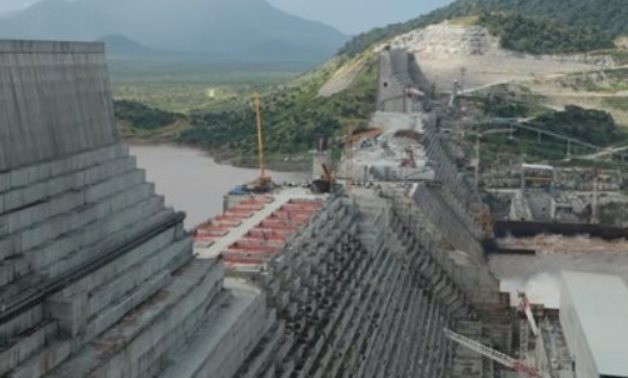
Grand Ethiopian Renaissance Dam - FILE
CAIRO- 19 April 2021: A day after Addis Ababa announced that two bottom outlets of Ethiopia’s Grand Ethiopian Renaissance Dam (GERD) have gone operational in preparation for implementing the second dam filling, Egypt revealed technical errors in the Ethiopian plan.
The Ethiopian claim that the two GERD bottom outlets are capable of enabling average flow of Blue Nile is incorrect, the Egyptian ministry said.
The capacity of releasing Nile water from these two bottom outlets does not exceed 50 million m3 / day, the ministry said, which means that this amount of water does not meet the needs of the two downstream countries (Egypt and Sudan). The ministry added that such amount of water is not equivalent to the average of water release coming from the Blue Nile.
Ethiopian Minister of Water, Irrigation and Energy Seleshi Bekele has announced on Sunday that the two bottom outlets have been completed and gone operational, Fana Broadcasting Corporate reported. the Ethiopian minister added that “other 13 outlets are under construction adding huge capacity of water release.”
In its statement, Egypt also added that the second filling process due to unilaterally implemented in mid-July by Ethiopia and seizing large amount of water will tremendously affect the Nile river system, as these two BO controls water flow to the other two countries.
Thus, “the situation will be more complicated starting from the flood season (Next July) as the BOs will release an amount lower than usual in July and August,” the Egyptian statement said.
The maximum flow of the two BOs is estimated at 3 billion m3 per month, and water level will be at 595 meters, Egypt added, noting that this process will affect the two downstream countries in moderate flood. “The situation will worsen when the flood level is low flood.”
“So, it evitable to reach a legal binding agreement that should include a clear mechanism of the dam operation,” Egypt said.
Also, Egypt revealed that it has previously asked Ethiopia in 2012 and 2015 to increase the capacity of the bottom outlets to meet the needs of the downstream countries, offering to finance the extra cost for expanding the BOS capacity, but Ethiopia claimed that such BOs are sufficient and can be operational.
In addition to this, Egypt said that the Ethiopian side was supposed to generate electricity after operating two turbines following the first phase of filing the dam last year, but Addis Ababa storing water without generating electricity. “This confirms that the first filling process was carried out for media and political reasons and not for technical ones,” Egypt’s Ministry of Irrigation said.
Egypt affirmed that the other 13 bottom outlets are not ready, and therefore generating electricity is not correct as there is a strong correlation between the readiness of the turbines for electricity generation and the amount of stored water.
“However, the Ethiopian side is rushing to impose a fait accompli policy on the two downstream countries through filling the dam reservoir for the second year although the dam is not ready for the planned electrical generation” Egypt said.
Regarding to what has been claimed by Ethiopia about the construction of the dam meets the international specifications and standard, Egypt affirms “this is an incorrect claim because Ethiopia is building the dam in an inconvenient manner.”
Egypt said there are many changes occurred in the auxiliary dam, the level of turbine holes, besides removing three turbine exits after their installation.
Cairo has shown great flexibility during the negotiations over the past ten years to reach a fair and binding legal agreement regarding the filling and operation of the dam, the statement sai.
In mid-July 2020, Ethiopian authorities unilaterally carried out the first phase of the filling process with 4.9 billion cubic meters; and it is expected that the second phase of the filling would reach 13 billion cubic meters.
The dispute among Egypt, Sudan, and Ethiopia dates back to May 2011 when Ethiopia started building the dam; Egypt voiced concern over its water share [55.5 billion cubic meters].
In 2015, the three countries signed the Declaration of Principles, per which the downstream countries should not be negatively affected by the construction of the dam, whose capacity is 74 billion cubic meters and is planned to generate 6,000 megawatts per annum through 16 turbines.
Comments
Leave a Comment